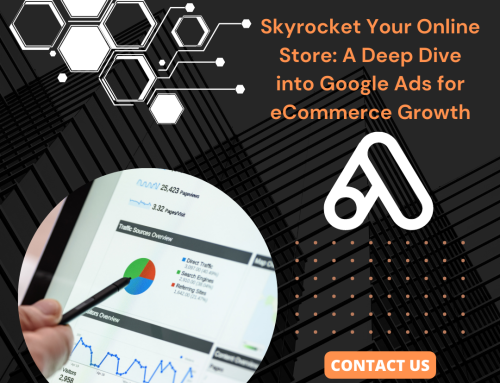Digital Advertising can be a daunting and overwhelming task for businesses, but it doesn't have to be. In this blog post, we'll cover how to identify your target audience, set clear goals, choose the right channels, create effective ad copy and visuals, optimize your budget, and track and analyze your efforts to ensure the success of your digital advertising campaigns.
Share This Story, Choose Your Platform!
Introduction
Definition of Digital Advertising:
Digital advertising refers to the use of online platforms to promote products or services to a target audience. This can include a variety of tactics, such as display ads, search engine marketing, social media advertising, email marketing, and more. Digital advertising allows businesses to reach a wider audience, target specific demographics and interests, and track the effectiveness of their campaigns through data and analytics.
Importance of Digital Advertising for businesses:
Digital advertising is important for businesses because it allows them to reach potential customers where they are spending most of their time – online. With the proliferation of the internet and the increasing use of mobile devices, more and more consumers are turning to the web to research products and services, making digital advertising an essential part of a modern marketing strategy. Digital advertising also allows businesses to target specific demographics and interests, which can be more cost-effective and efficient than traditional forms of advertising.
Challenges of Digital Advertising:
Despite the many benefits of digital advertising, it can also present challenges for businesses. One challenge is the constantly changing landscape of digital advertising, with new platforms and technologies emerging all the time. This can make it difficult for businesses to keep up with the latest trends and best practices. Additionally, digital advertising can be competitive, with businesses vying for attention in a crowded online space. This can make it difficult for businesses to stand out and effectively reach their target audience. Finally, the complexity of digital advertising can be intimidating for businesses, particularly those that are new to the space or have limited resources. This can make it difficult for businesses to effectively plan and execute successful digital advertising campaigns.
Identifying your target audience:
Identifying your target audience is an essential first step in creating successful digital advertising campaigns. Your target audience is the specific group of people that you are trying to reach and persuade with your advertising efforts. Understanding who your target audience is will help you create ads that are more relevant and effective in achieving your business objectives.
Understanding your customer demographics and behavior:
To effectively identify your target audience, it’s important to understand your customer demographics and behavior. Demographic information can include things like age, gender, income level, education level, and location. Understanding the demographics of your customers can help you create ads that are more tailored to their specific characteristics. In addition to demographics, it’s also important to understand the behavior of your customers – how they interact with your brand, what motivates them to make a purchase, and what challenges they face. This information can help you create ads that more effectively address their needs and desires.
Defining your target audience through buyer personas:
One way to better understand your target audience is to create buyer personas – fictional representations of your ideal customer based on research and data. By creating buyer personas, you can better understand the motivations, goals, and challenges of your target audience, which can help you create more effective advertising campaigns.
Finding your target audience through market research:
In addition to creating buyer personas, you can also use market research to better understand your target audience. Market research can include things like surveys, focus groups, and online analytics. This research can help you gather valuable insights about your customers, including their demographics, behavior, and preferences. By using market research, you can better understand who your target audience is and how to effectively reach them through digital advertising.
Setting clear goals for your digital advertising campaigns:
Setting clear goals for your digital advertising campaigns is essential for measuring their success and ensuring that they are aligned with your overall business objectives. Without clear goals, it can be difficult to know if your campaigns are effective and how to improve them.
Identifying your business objectives:
Before setting specific goals for your digital advertising campaigns, it’s important to first identify your overall business objectives. These could include things like increasing brand awareness, generating leads, driving sales, or improving customer loyalty. Understanding your business objectives will help you create campaigns that are more closely aligned with your overall goals.
Choosing the right metric to measure success:
Once you have identified your business objectives, you can then choose the right metric to measure the success of your digital advertising campaigns. Different metrics will be more relevant depending on your specific goals. For example, if your goal is to increase brand awareness, you might measure success by tracking the number of impressions your ads receive. If your goal is to generate leads, you might track the number of form submissions or phone calls you receive. Choosing the right metric to measure success will help you better understand the effectiveness of your campaigns.
Setting realistic and specific goals:
It’s important to set specific, measurable, achievable, relevant, and time-bound (SMART) goals for your digital advertising campaigns. This will help you create more realistic and actionable goals that you can work towards. For example, instead of setting a goal to “increase sales,” you might set a goal to “increase online sales by 10% in the next quarter.” This goal is specific, measurable, achievable, relevant, and time-bound, which makes it more actionable and easier to track progress towards.
Choosing the right channels for your digital advertising:
Choosing the right channels for your digital advertising is essential for reaching your target audience and achieving your business goals. There are a variety of different channels to choose from, and it’s important to select the ones that align with your specific target audience and goals.
Understanding the different types of digital advertising channels:
There are many different types of digital advertising channels to choose from, including:
- Display ads: Display ads are banner ads that appear on websites, typically on the top, bottom, or side of the page. These ads can be text, image, or video-based.
- Search engine marketing (SEM): SEM refers to the use of paid search ads that appear at the top or bottom of search engine results pages (SERPs). These ads are typically based on keywords that users search for and are bid on by advertisers.
- Social media advertising: Social media advertising refers to the use of social media platforms, such as Facebook, Instagram, and LinkedIn, to promote products or services. These ads can be targeted to specific demographics and interests.
- Email marketing: Email marketing refers to the use of email to promote products or services. This can include newsletters, promotional emails, and automated email campaigns.
- Mobile advertising: Mobile advertising refers to the use of mobile apps or mobile websites to promote products or services. This can include things like banner ads, interstitial ads, and native ads.
Selecting the channels that align with your target audience and goals:
Once you understand the different types of digital advertising channels available, it’s important to select the ones that align with your target audience and goals. For example, if your target audience is primarily young adults, you might consider using social media advertising on platforms like Instagram and TikTok. If your goal is to drive sales, you might consider using search engine marketing to target users who are actively searching for products or services.
Testing and analyzing the effectiveness of different channels:
It’s important to test and analyze the effectiveness of different channels to see which ones are most effective in achieving your goals. This can involve setting up tracking and measurement tools, such as Google Analytics, and regularly analyzing the performance of your campaigns. By testing and analyzing different channels, you can make data-driven decisions to optimize your digital advertising efforts.
Creating effective ad copy and visuals:
Creating effective ad copy and visuals is essential for engaging and persuading your target audience through digital advertising. The ad copy is the text that appears in your ad, while the visuals are the images or videos that accompany the ad. Both the ad copy and visuals should be compelling and relevant to your target audience to be effective.
Writing compelling headlines and descriptions:
The headline and description of your ad are crucial for grabbing the attention of your target audience and persuading them to take action. A good headline should be attention-grabbing and clearly communicate the value of your product or service. The description should expand on the benefits of your offering and include a call to action, such as “Learn More” or “Buy Now.”
Using persuasive language and calls to action:
In addition to writing compelling headlines and descriptions, it’s also important to use persuasive language and calls to action in your ad copy. This can involve using language that addresses the needs and desires of your target audience, such as “Get the perfect fit with our custom sizing options” or “Experience the benefits of our all-natural ingredients.” Calls to action, such as “Sign Up Now” or “Add to Cart,” should be specific and clear, encouraging the reader to take the next step.
Choosing visually appealing and relevant images and videos:
The visuals that accompany your ad, such as images and videos, should be visually appealing and relevant to your target audience. This can involve selecting images and videos that showcase your product or service in an attractive and compelling way. It’s also important to choose visuals that are relevant to your target audience and align with your overall business objectives. For example, if you are targeting outdoor enthusiasts, you might choose images of people enjoying outdoor activities.
Optimizing your digital advertising budget:
Optimizing your digital advertising budget is essential for maximizing the return on your investment (ROI) and ensuring that you are getting the most value for your money. By setting and managing your budget effectively, you can improve the effectiveness of your campaigns and achieve your business objectives.
Setting a budget based on your goals and resources:
When setting your digital advertising budget, it’s important to consider your overall business goals and the resources you have available. Your budget should be aligned with your goals and should take into account your available resources, such as time and personnel. It’s also important to consider the cost of different digital advertising channels, as well as any additional costs, such as design or production costs.
Testing and adjusting your budget to maximize ROI:
Once you have set your budget, it’s important to regularly test and adjust it to maximize ROI. This can involve setting up tracking and measurement tools, such as Google Analytics, to track the performance of your campaigns. By analyzing the data, you can identify which campaigns are most effective and adjust your budget accordingly. For example, if one campaign is generating a higher return on investment than another, you might choose to allocate more of your budget towards that campaign.
Utilizing cost-effective strategies, such as retargeting and automation:
There are a variety of cost-effective strategies that businesses can use to optimize their digital advertising budget. One strategy is retargeting, which involves showing ads to users who have previously visited your website but have not converted. This can be a cost-effective way to bring users back to your website and encourage them to take action. Another strategy is automation, which can help businesses save time and resources by automating tasks, such as ad placement and bidding. By using these and other cost-effective strategies, businesses can make the most of their digital advertising budget.
Tracking and analyzing your digital advertising efforts:
Tracking and analyzing the performance of your digital advertising efforts is essential for understanding what is working and what isn’t, and for making data-driven decisions to improve the effectiveness of your campaigns. By regularly analyzing your campaigns, you can identify areas for improvement and optimize your efforts to achieve your business goals.
Setting up tracking and measurement tools, such as Google Analytics:
To track and analyze the performance of your digital advertising efforts, it’s important to set up tracking and measurement tools. Google Analytics is a popular tool that allows businesses to track website traffic, conversions, and other key metrics. By setting up tracking and measurement tools, you can gather valuable data about the performance of your campaigns and use it to make informed decisions about how to optimize your efforts.
Regularly analyzing the performance of your campaigns:
Once you have set up tracking and measurement tools, it’s important to regularly analyze the performance of your campaigns. This can involve reviewing key metrics, such as clicks, impressions, and conversions, to understand how well your campaigns are performing. By regularly analyzing the data, you can identify trends and patterns that can help you optimize your campaigns and achieve your business goals.
Making data-driven decisions to improve the effectiveness of your digital advertising:
By tracking and analyzing the performance of your campaigns, you can make data-driven decisions to improve the effectiveness of your digital advertising. This can involve adjusting your budget, testing different ad copy and visuals, or targeting different audiences. By using data to inform your decisions, you can make more informed and effective changes to your campaigns to achieve your business objectives.
Conclusion:
In conclusion, digital advertising is an essential part of a modern marketing strategy, allowing businesses to reach a wider audience, target specific demographics and interests, and track the effectiveness of their campaigns. However, digital advertising can also present challenges, such as the constantly changing landscape and the complexity of the space. To take the headache out of digital advertising, it’s important to identify your target audience, set clear goals, choose the right channels, create effective ad copy and visuals, optimize your budget, and track and analyze your efforts. By following these steps, you can create successful digital advertising campaigns that effectively reach your target audience and achieve your business objectives.
Recap of key takeaways:
- Identify your target audience by understanding their demographics and behavior and creating buyer personas.
- Set clear goals for your digital advertising campaigns that are aligned with your business objectives and use the right metric to measure success.
- Choose the right channels for your digital advertising that align with your target audience and goals and test and analyze the effectiveness of different channels.
- Create effective ad copy and visuals that are compelling and relevant to your target audience.
- Optimize your digital advertising budget by setting a budget based on your goals and resources, testing and adjusting your budget to maximize ROI, and using cost-effective strategies like retargeting and automation.
- Track and analyze the performance of your digital advertising efforts to make data-driven decisions to improve the effectiveness of your campaigns.
Importance of ongoing optimization and analysis in digital advertising:
It’s important to note that digital advertising is an ongoing process that requires ongoing optimization and analysis. By regularly tracking and analyzing the performance of your campaigns, you can identify areas for improvement and make data-driven decisions to optimize your efforts. By staying up-to-date with the latest trends and best practices in digital advertising, you can ensure that your campaigns are as effective as possible in achieving your business objectives.
Discover effective strategies to simplify your digital advertising approach and alleviate challenges with these actionable insights from Purple Cow Services.
Share This Story, Choose Your Platform!
In This Blog:

















